Yonggang Zhang
Enhancing Target-unspecific Tasks through a Features Matrix
May 07, 2025Abstract:Recent developments in prompt learning of large vision-language models have significantly improved performance in target-specific tasks. However, these prompt optimizing methods often struggle to tackle the target-unspecific or generalizable tasks effectively. It may be attributed to the fact that overfitting training causes the model to forget its general knowledge having strong promotion on target-unspecific tasks. To alleviate this issue, we propose a novel Features Matrix (FM) regularization approach designed to enhance these models on target-unspecific tasks. Our method extracts and leverages general knowledge, shaping a Features Matrix (FM). Specifically, the FM captures the semantics of diverse inputs from a deep and fine perspective, preserving essential general knowledge, which mitigates the risk of overfitting. Representative evaluations demonstrate that: 1) the FM is compatible with existing frameworks as a generic and flexible module, and 2) the FM significantly showcases its effectiveness in enhancing target-unspecific tasks, achieving state-of-the-art performance.
* ICML 2025
Leveraging Submodule Linearity Enhances Task Arithmetic Performance in LLMs
Apr 15, 2025



Abstract:Task arithmetic is a straightforward yet highly effective strategy for model merging, enabling the resultant model to exhibit multi-task capabilities. Recent research indicates that models demonstrating linearity enhance the performance of task arithmetic. In contrast to existing methods that rely on the global linearization of the model, we argue that this linearity already exists within the model's submodules. In particular, we present a statistical analysis and show that submodules (e.g., layers, self-attentions, and MLPs) exhibit significantly higher linearity than the overall model. Based on these findings, we propose an innovative model merging strategy that independently merges these submodules. Especially, we derive a closed-form solution for optimal merging weights grounded in the linear properties of these submodules. Experimental results demonstrate that our method consistently outperforms the standard task arithmetic approach and other established baselines across different model scales and various tasks. This result highlights the benefits of leveraging the linearity of submodules and provides a new perspective for exploring solutions for effective and practical multi-task model merging.
Generalizable Prompt Learning of CLIP: A Brief Overview
Mar 03, 2025


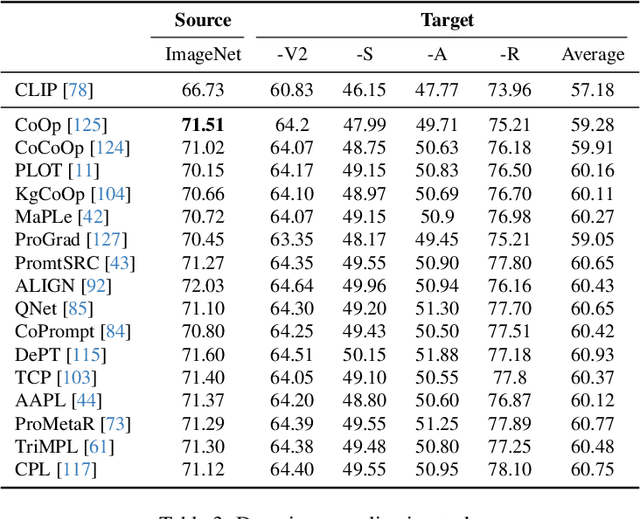
Abstract:Existing vision-language models (VLMs) such as CLIP have showcased an impressive capability to generalize well across various downstream tasks. These models leverage the synergy between visual and textual information, enabling them to understand and reason about the content present in images and text in a unified manner. This article provides a brief overview of CLIP based on few-shot prompt learning, including experimental data and technical characteristics of some methods. The purpose of this review is to provide a reference for researchers who have just started their research in generalizable prompting of CLIP through few-shot training for classification across 15 datasets and also to facilitate the integration of this field by researchers in other downstream tasks.
Detecting Discrepancies Between AI-Generated and Natural Images Using Uncertainty
Dec 08, 2024



Abstract:In this work, we propose a novel approach for detecting AI-generated images by leveraging predictive uncertainty to mitigate misuse and associated risks. The motivation arises from the fundamental assumption regarding the distributional discrepancy between natural and AI-generated images. The feasibility of distinguishing natural images from AI-generated ones is grounded in the distribution discrepancy between them. Predictive uncertainty offers an effective approach for capturing distribution shifts, thereby providing insights into detecting AI-generated images. Namely, as the distribution shift between training and testing data increases, model performance typically degrades, often accompanied by increased predictive uncertainty. Therefore, we propose to employ predictive uncertainty to reflect the discrepancies between AI-generated and natural images. In this context, the challenge lies in ensuring that the model has been trained over sufficient natural images to avoid the risk of determining the distribution of natural images as that of generated images. We propose to leverage large-scale pre-trained models to calculate the uncertainty as the score for detecting AI-generated images. This leads to a simple yet effective method for detecting AI-generated images using large-scale vision models: images that induce high uncertainty are identified as AI-generated. Comprehensive experiments across multiple benchmarks demonstrate the effectiveness of our method.
Enhancing Multiple Dimensions of Trustworthiness in LLMs via Sparse Activation Control
Nov 04, 2024



Abstract:As the development and application of Large Language Models (LLMs) continue to advance rapidly, enhancing their trustworthiness and aligning them with human preferences has become a critical area of research. Traditional methods rely heavily on extensive data for Reinforcement Learning from Human Feedback (RLHF), but representation engineering offers a new, training-free approach. This technique leverages semantic features to control the representation of LLM's intermediate hidden states, enabling the model to meet specific requirements such as increased honesty or heightened safety awareness. However, a significant challenge arises when attempting to fulfill multiple requirements simultaneously. It proves difficult to encode various semantic contents, like honesty and safety, into a singular semantic feature, restricting its practicality. In this work, we address this issue through ``Sparse Activation Control''. By delving into the intrinsic mechanisms of LLMs, we manage to identify and pinpoint components that are closely related to specific tasks within the model, i.e., attention heads. These heads display sparse characteristics that allow for near-independent control over different tasks. Our experiments, conducted on the open-source Llama series models, have yielded encouraging results. The models were able to align with human preferences on issues of safety, factuality, and bias concurrently.
FuseFL: One-Shot Federated Learning through the Lens of Causality with Progressive Model Fusion
Oct 27, 2024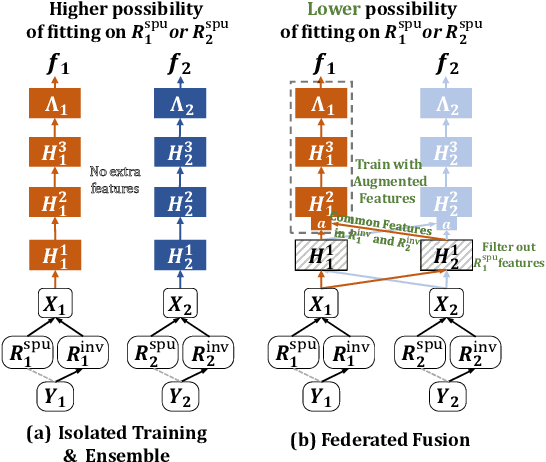
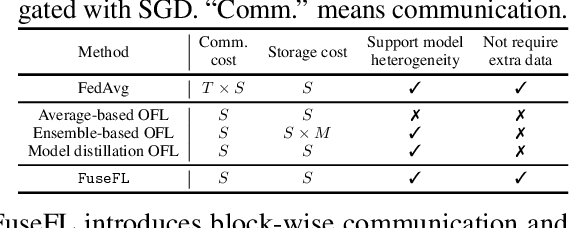


Abstract:One-shot Federated Learning (OFL) significantly reduces communication costs in FL by aggregating trained models only once. However, the performance of advanced OFL methods is far behind the normal FL. In this work, we provide a causal view to find that this performance drop of OFL methods comes from the isolation problem, which means that local isolatedly trained models in OFL may easily fit to spurious correlations due to the data heterogeneity. From the causal perspective, we observe that the spurious fitting can be alleviated by augmenting intermediate features from other clients. Built upon our observation, we propose a novel learning approach to endow OFL with superb performance and low communication and storage costs, termed as FuseFL. Specifically, FuseFL decomposes neural networks into several blocks, and progressively trains and fuses each block following a bottom-up manner for feature augmentation, introducing no additional communication costs. Comprehensive experiments demonstrate that FuseFL outperforms existing OFL and ensemble FL by a significant margin. We conduct comprehensive experiments to show that FuseFL supports high scalability of clients, heterogeneous model training, and low memory costs. Our work is the first attempt using causality to analyze and alleviate data heterogeneity of OFL.
From Yes-Men to Truth-Tellers: Addressing Sycophancy in Large Language Models with Pinpoint Tuning
Sep 03, 2024



Abstract:Large Language Models (LLMs) tend to prioritize adherence to user prompts over providing veracious responses, leading to the sycophancy issue. When challenged by users, LLMs tend to admit mistakes and provide inaccurate responses even if they initially provided the correct answer. Recent works propose to employ supervised fine-tuning (SFT) to mitigate the sycophancy issue, while it typically leads to the degeneration of LLMs' general capability. To address the challenge, we propose a novel supervised pinpoint tuning (SPT), where the region-of-interest modules are tuned for a given objective. Specifically, SPT first reveals and verifies a small percentage (<5%) of the basic modules, which significantly affect a particular behavior of LLMs. i.e., sycophancy. Subsequently, SPT merely fine-tunes these identified modules while freezing the rest. To verify the effectiveness of the proposed SPT, we conduct comprehensive experiments, demonstrating that SPT significantly mitigates the sycophancy issue of LLMs (even better than SFT). Moreover, SPT introduces limited or even no side effects on the general capability of LLMs. Our results shed light on how to precisely, effectively, and efficiently explain and improve the targeted ability of LLMs.
Interpreting and Improving Large Language Models in Arithmetic Calculation
Sep 03, 2024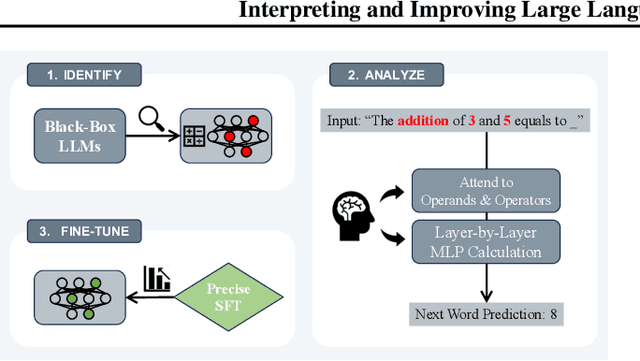

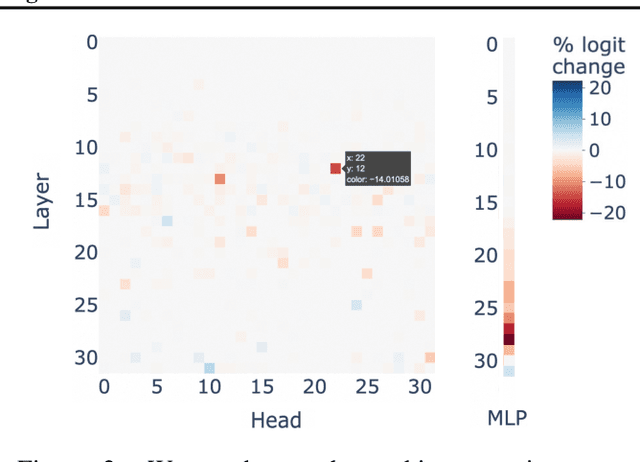
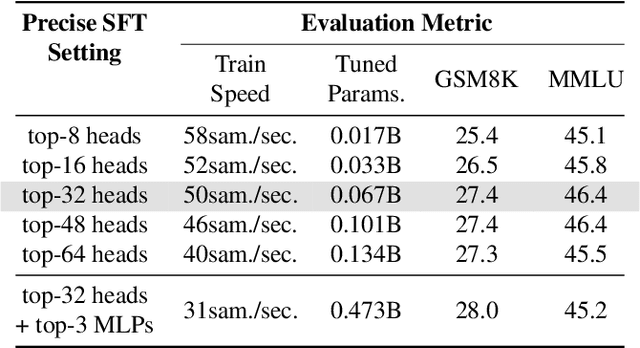
Abstract:Large language models (LLMs) have demonstrated remarkable potential across numerous applications and have shown an emergent ability to tackle complex reasoning tasks, such as mathematical computations. However, even for the simplest arithmetic calculations, the intrinsic mechanisms behind LLMs remain mysterious, making it challenging to ensure reliability. In this work, we delve into uncovering a specific mechanism by which LLMs execute calculations. Through comprehensive experiments, we find that LLMs frequently involve a small fraction (< 5%) of attention heads, which play a pivotal role in focusing on operands and operators during calculation processes. Subsequently, the information from these operands is processed through multi-layer perceptrons (MLPs), progressively leading to the final solution. These pivotal heads/MLPs, though identified on a specific dataset, exhibit transferability across different datasets and even distinct tasks. This insight prompted us to investigate the potential benefits of selectively fine-tuning these essential heads/MLPs to boost the LLMs' computational performance. We empirically find that such precise tuning can yield notable enhancements on mathematical prowess, without compromising the performance on non-mathematical tasks. Our work serves as a preliminary exploration into the arithmetic calculation abilities inherent in LLMs, laying a solid foundation to reveal more intricate mathematical tasks.
SpectralKAN: Kolmogorov-Arnold Network for Hyperspectral Images Change Detection
Jul 01, 2024



Abstract:It has been verified that deep learning methods, including convolutional neural networks (CNNs), graph neural networks (GNNs), and transformers, can accurately extract features from hyperspectral images (HSIs). These algorithms perform exceptionally well on HSIs change detection (HSIs-CD). However, the downside of these impressive results is the enormous number of parameters, FLOPs, GPU memory, training and test times required. In this paper, we propose an spectral Kolmogorov-Arnold Network for HSIs-CD (SpectralKAN). SpectralKAN represent a multivariate continuous function with a composition of activation functions to extract HSIs feature and classification. These activation functions are b-spline functions with different parameters that can simulate various functions. In SpectralKAN, a KAN encoder is proposed to enhance computational efficiency for HSIs. And a spatial-spectral KAN encoder is introduced, where the spatial KAN encoder extracts spatial features and compresses the spatial dimensions from patch size to one. The spectral KAN encoder then extracts spectral features and classifies them into changed and unchanged categories. We use five HSIs-CD datasets to verify the effectiveness of SpectralKAN. Experimental verification has shown that SpectralKAN maintains high HSIs-CD accuracy while requiring fewer parameters, FLOPs, GPU memory, training and testing times, thereby increasing the efficiency of HSIs-CD. The code will be available at https://github.com/yanhengwang-heu/SpectralKAN.
A 7K Parameter Model for Underwater Image Enhancement based on Transmission Map Prior
May 25, 2024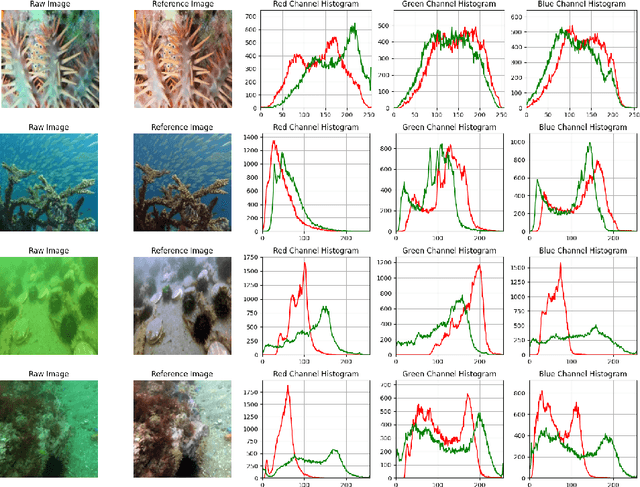

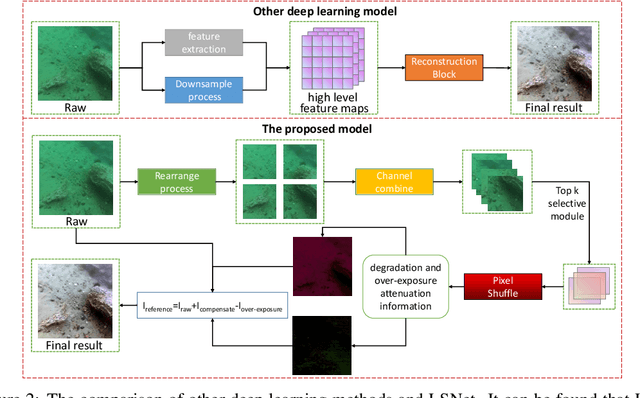

Abstract:Although deep learning based models for underwater image enhancement have achieved good performance, they face limitations in both lightweight and effectiveness, which prevents their deployment and application on resource-constrained platforms. Moreover, most existing deep learning based models use data compression to get high-level semantic information in latent space instead of using the original information. Therefore, they require decoder blocks to generate the details of the output. This requires additional computational cost. In this paper, a lightweight network named lightweight selective attention network (LSNet) based on the top-k selective attention and transmission maps mechanism is proposed. The proposed model achieves a PSNR of 97\% with only 7K parameters compared to a similar attention-based model. Extensive experiments show that the proposed LSNet achieves excellent performance in state-of-the-art models with significantly fewer parameters and computational resources. The code is available at https://github.com/FuhengZhou/LSNet}{https://github.com/FuhengZhou/LSNet.
 Add to Chrome
Add to Chrome Add to Firefox
Add to Firefox Add to Edge
Add to Edge